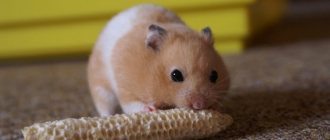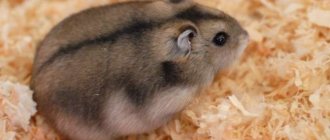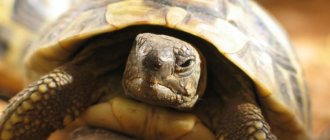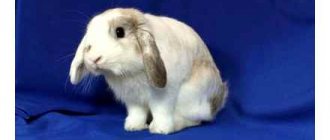Hamsters are small rodents that can make wonderful pets if kept well and properly. There are several breeds of these furry animals. And in this article we will look at all the main breeds of hamsters with photographs and names.
Popular Domestic Breeds
In this section of the article, we will look at the types of domestic hamsters that are widespread among people.
Syrian
This breed was first brought to England as a pet by the British Consul in 1880. Due to its most common golden-red color, the Syrian hamster has acquired the second name “golden hamster”. The color of these hamsters can also be black, brown, white, blue, etc. Weight varies between 100-150 grams, body length averages 13-14.5 cm.
Among all breeds, Syrians are long-lived, living about 2.5 years, and with careful care they can live up to 4-6. By nature they are very kind, active and restless animals.
In the wild, it lives in shallow burrows, where it spends most of the daytime. Leads an active nocturnal lifestyle. It feeds on cereal grains, berries, fruits, vegetables, small insects and worms. It has large cheek pouches, which it uses to carry food and raw materials for building nests. These hamsters form pairs only during the mating period, as they prefer a bachelor lifestyle. The female's pregnancy lasts eighteen days, after which four to fourteen cubs are born.
What does such a pet look like, look at the photo:
Dzungarian
This hamster got its name from a province in western China - Dzungaria. A small rodent, reaching a length of only ten centimeters, weighing 35 - 55 grams. The most common color: white legs and belly, grayish-brown back with a black stripe along the entire spine. Life expectancy is up to two years. They are independent in nature, but are easily tamed.
The Djungarian hamster builds a hole for itself with many branches, each of which has its own purpose: bedroom, food storage, toilet. The dzhungarik is a nocturnal animal; it sits in its hole all day, and as soon as it gets dark, it comes out for food. The diet contains a large amount of seeds, berries, grass and insects. Gestation lasts 17-25 days and mostly four to six babies are born.
Campbell
A dwarf hamster that lives in the steppes of Russia, Mongolia, China and Kazakhstan.
The color of this breed has three main types:
- usual color – agouti;
- cinnamon or sand colors - Argentinean;
- white - albino.
Also available in spotted, pearl, blue and black. The body length is on average 8 - 10 cm, the animals weigh no more than 40 grams. They usually live up to 1.5 – 2 years. Nature deprived these hamsters of vision, but compensated with a large number of glands located throughout the body. Campbell's hamsters, unlike Syrian hamsters, prefer to live in a cooperative with their relatives. In captivity, they can live in mixed colonies, that is, females with males, but it is still recommended to keep them separately.
In the wild, deep holes are dug, some of which can be up to two meters deep. Campbell, like all the breeds described above, leads a predominantly nocturnal lifestyle, since many enemies await it on the surface. Natural enemies are birds of prey, foxes, and weasels. These small rodents feed on seeds, vegetables, grains, and berries. They enter the sexually mature period in the fifth week, pregnancy lasts on average twenty days, with a litter of four to seven cubs. It is worth noting that males, along with females, take part in raising offspring, unlike Djungarian and Syrian hamsters.
Taylor
A small animal, barely reaching ten centimeters in length, and weighing no more than 150 grams. This hamster loves a sunny climate, so it has inhabited Central and Southern Mexico, Arizona, Texas, as well as the islands of Aruba and Curacao. For housing, it mainly uses natural holes and depressions located in dense grass. Hamsters prefer tall and dense grass for safety reasons, as it is easy to hide in it and confuse their tracks. The main color is gray, but other colors may occur.
They go out for food at dusk; the main diet includes grass, seeds, roots, insects and butterflies. Pregnancy lasts up to twenty days, with a litter of one to four rodents. In captivity they take root well if taken at a young age. This is a very active and agile animal, constantly on the move.
Chinese
A miniature hamster, common in Northern China and areas of Mongolia. The color of these hamsters can be either regular brown or white-gray with a dark stripe on the back. A distinctive feature is the presence of a long tail, which looks like a rat's tail. Body length is within ten to twelve centimeters, weight up to 200 grams. They are good-natured and active in nature, so in captivity they should be bred in a large room with a wheel, otherwise they will get bored. They feed on grass, seeds, berries and grains.
In the wild they live no more than two years, in captivity they live up to three to four years. The female carries the fetus in her womb for 18 to 21 days, and two or three cubs are born. After giving birth, the female becomes aggressive towards the male. These hamsters are relatively difficult to breed, so they are not often found in pet stores.
Roborovsky
The smallest member of the family. The body length is no more than 5 cm, and the weight is up to 30 grams. With proper care they can live up to four years. Rodents have a snub nose and white eyebrows. The fur color can be golden, cream, sandy or agouti. These animals have a developed social life and interact very well with each other. They cost an order of magnitude more than other breeds, as they do not reproduce well in captivity.
Fictional breeds
There are about 20 varieties of hamsters on the planet, but sometimes groups of hamsters with certain characteristics are mistakenly classified as separate non-existent breeds. Such fictitious breeds will be discussed in this section.
Albino
Albinos are hamsters whose bodies do not produce the hormone melanin. As a result, they have white fur and red eyes, with blood vessels visible through the colorless iris. They have increased sensitivity to light. Such hamsters are not classified as a separate breed, because this is only a malfunction of the genetic apparatus of a Syrian, Djungarian or any other breed of hamster.
Angora
This is an artificially bred long-haired Syrian hamster. It got its name because of its shaggy coat, which looks like the fur of an Angora goat. Distinctive features are the absence of a tail, small front legs, large cheeks and long hair, which in males reaches 5 cm. The color can be different: spotted, cream, white, black.
Royal
The shaggy golden Syrian hamster is passed off as a royal hamster. But there is no such breed; usually this is done to obtain the greatest benefit.
Black
A black hamster can be a Syrian, Djungarian, or Chinese hamster, because it is not a separate breed, but simply a fur color. Black hamsters are considered animals that do not have any spots of a different color on their body. It is acceptable to have white color on the toes and paws. They are very difficult to breed, which is why they are expensive.
Golden
There is no breed of golden hamster. This is sometimes the name given to Syrian hamsters, whose skin color has a bright golden-sandy hue.
White
White hamsters are usually albinos. They are often passed off as a separate rare species by pet store sellers to make more profit.
Main differences
Despite many similar features, the main differences are highlighted:
Wool
The Djungarian hamster has dense fur, it is quite smooth and shiny. Campbells have a wavy coat and appear a little shaggy in appearance.
Color
Campbell's main shades:
- orange (mandarin)
- pearl
- sapphire.
Often, hamsters are red in color, have a uniform color, and have a dark stripe on the back.
A rare shade found in this species is agouti; even more rare are albino, argent, opal, gray, blue, spotted. The fur is somewhat disheveled.
Djungarians can come in a wide variety of colors, but their distinctive feature is stripes on the sides, on the back and a diamond on the face. The coat lies tightly and smooth.
Another important point is that in the cold season, Campbells have a change in coat color, and the Djungarian hamster may have a change in the stripe on its back, completely matching the main shade.
Anatomical differences
Dzungariks have an oval carcass that looks like an oval. Campbells externally repeat the outline of the number 8, due to the presence of a waist. The Djungarian rodent never has red eyes, while others do, but quite rarely. The Djungarian hamster has larger ears than the Campbell's.
Behavior
Many people like Djungarian hamsters and often get them: thanks to their friendliness, they are easily tamed and easy to get along with.
Campbell's rodent, on the contrary, is aggressive, and it is almost impossible to tame it. Both breeds are quite active animals; they love to run in a wheel, bury themselves in sawdust and create order in the bowl, creating noise.
Wild and less popular breeds
We have listed the most common breeds, but there are many more of them in nature. In this section we will look at what other hamsters there are.
Common (forest)
The common hamster is quite large; its body length can reach thirty-four centimeters. It lives mainly in the steppes and likes to settle near human habitations. Externally it has a bright color and a long tail. Its back is reddish-brown, there are white spots on the sides, and its belly is black. Life expectancy in the wild is four years, and in captivity up to six years.
Radde
A rodent that lives mainly in mountainous areas. The hamster's fur is brown-chocolate on top, its abdomen is dark, and its tail is long. There are whitish spots along the face and ears. A large animal, body length up to thirty cm, weight varies up to one kilogram. He prefers to eat grass and grains. In the wild it lives up to three years.
Barabinsky
Inhabitant of forest-steppes and deserts, widely distributed in Mongolia. The skin is gray in color with a reddish tint; a black stripe extends along the back along the spine. A distinctive feature is the two-color ears, edged with a white stripe.
Brandt
It got its name from the name of a German zoologist. Lives in the mountainous regions of Iran, Turkey and Transcaucasia. The top is brownish-earthy in color, the bottom is gray, the belly is light with a black spot. There are two white stripes along the neck, dividing the head and neck into parts. Life expectancy is up to two years.
Siberian
The dwarf rodent has a body length that reaches only ten centimeters, and a weight of about thirty grams. In summer the skin is gray, and in winter it changes into a snow-white outfit. The Siberian hamster is an affectionate and friendly animal. In the wild it lives up to two years; at home it can live up to three years.
Rat-like
A resident of Northern China often ends up being handed out sticks by local residents, as he causes significant damage to agricultural crops. In appearance, the hamster is very similar to a rat; it has a tail up to ten centimeters long. The fur color is gray with a white belly.
Grasshopper
This predatory hamster lives in Mexico and Canada. It eats only lizards and insects; sometimes it eats scorpions, to whose poison the rodent is immune. It has a brown back and a light belly. In moments of danger they emit a characteristic squeak, popularly called a hamster howl.
Kansky
Little known species. It lives in the forests of China and is known to build its nests on the surface of the ground. The body length is seventeen centimeters, the tail is ten centimeters long. The skin is gray in color, with white spots on the large cheeks.
Grey
Belongs to the genus of gray hamsters; in some regions the rodent is listed in the Red Book. It is covered with a gray skin with a white belly. It also has large cheek pouches and small ears. This animal never digs holes for itself, preferring to occupy other people's.
Eversmann
It was named after the Russian zoologist and physician Eduard Eversmann. Just like the gray hamster in some areas is listed in the Red Book. The main habitat is Kazakhstan. It has different colors and a small tail. It feeds on cereals, legumes, grass and berries.
Newton's hamster
A small animal with diligence and hard work, but with an evil character. The fur color is brown with a black stripe coming from the head. It digs huge holes for itself, from which it emerges only at night.
Tibetan
Lives in the grasslands of western China. They grow up to eight to ten centimeters in length, with a tail up to five centimeters long. The fur is dark gray with black accents. They feed on seeds, grains, berries and grass.
What other types of hamsters are there?
Existing species of rodents are very diverse. But they are not very friendly, they prefer a natural lifestyle, so they are rarely found in the home cage:
- The rat hamster looks like a rat. The gray fur is soft and smooth, and the long tail is covered with feathering. In nature, he likes to dig holes. Under the ground, the rat-like hamster builds entire settlements where it stores supplies.
- The shaggy hamster is very similar to a porcupine: its coarse hair creates the appearance of quills. The animal protects itself from predators by releasing a foul-smelling liquid from its scent glands.
Shaggy hamster
Interesting! The wombat, a marsupial mammal, lives in Australia. The animal is often called the Australian hamster because in appearance it is very similar to the thick-cheeked rodent.
How to determine the breed
You can determine the breed of a hamster by studying its characteristic features, color, tail length and size. It is worth carefully examining all these characteristics so as not to make a mistake with your choice.
At the end of the article, I would like to share one interesting fact about hamsters: almost all Syrian hamsters descended from one female, who gave birth to twelve babies in 1930.
Features of black hamsters
Black color is quite rare in hamsters. A rodent is not considered black if its fur is unevenly colored , for example, there are white spots or specks on the abdomen. And only the white spots on the toes make it possible to determine the color of the hamster as black.
But apart from beautiful and bright dark fur, the black hamster is no different from its relatives: the physique, weight and size of hamsters are the same. Dark-colored rodents, like their comrades, are very clean, curious, active and playful.
How to care
A home for a black hamster can be an aquarium or a cage. You need to choose a spacious house for your pet, because hamsters actively move, scurry around and do not like to sit still. Such an apartment will resemble a mink.
If you have several pets, you can purchase a two-story cage. Moreover, hamsters love to climb everywhere. But you don’t need to make the cage too high so that the animal doesn’t get hurt if it suddenly breaks and falls. The best solution would be to purchase a metal cage to ensure that your pet will not escape from its hole.
The temperature in the room where the hamster lives should be comfortable - not lower than 20 degrees. You should not leave your pet in an open draft, because animals easily catch colds and get sick.
You need to feed the animal with pieces of vegetables and fruits, leaves of fresh herbs, and be sure to ensure that the pet has free access to clean drinking water in the drinking bowl. You can buy a drinking bowl in a store or make it yourself.











